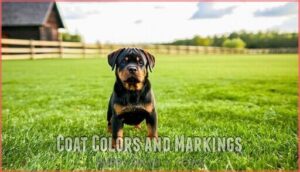This site is supported by our readers. We may earn a commission, at no cost to you, if you purchase through links.

While they might inherit the loyalty and protective instincts of regular Rottweilers, their compact size comes at a steep cost—chronic bone fragility, organ dysfunction, and weakened immune systems are common. Most reputable kennel clubs don’t recognize them because the breeding methods often prioritize profit over the dog’s wellbeing.
Before you fall for those adorable photos, there’s more you need to know about what really goes into creating these controversial "pocket-sized" companions.
Table Of Contents
- Key Takeaways
- What is a Teacup Rottweiler?
- Teacup Rottweiler Appearance and Size
- Temperament and Suitability as Pets
- Health Risks and Care Requirements
- Buying and Ethical Considerations
- Frequently Asked Questions (FAQs)
- Are teacup Rottweilers recognized by the American Kennel Club?
- How big is the litter size for teacup Rottweilers?
- What training methods work best for teacup Rottweilers?
- What type of food should I feed my teacup Rottweiler?
- Can teacup Rottweilers live in small apartments?
- What vaccines do teacup Rottweilers need?
- How long do teacup Rottweilers sleep daily?
- Are teacup Rottweilers good with children?
- Do teacup Rottweilers shed excessively?
- Conclusion
Key Takeaways
- Teacup Rottweilers aren’t a real breed – You’re looking at crossbred dogs or runts with dwarfism that major kennel clubs don’t recognize, created through questionable breeding practices rather than established standards.
- You’ll face serious health problems – These dogs suffer from chronic bone fragility, organ dysfunction, weakened immune systems, and shortened lifespans due to extreme miniaturization methods.
- You’re supporting unethical breeding – Most teacup Rottweilers come from puppy mills that prioritize profit over animal welfare, using harmful practices like inbreeding and selecting runts with genetic defects.
- You’ll pay premium prices for health risks – These dogs cost $3,000-5,000 despite their medical problems, making standard Rottweilers or other small purebred dogs healthier and more ethical alternatives.
What is a Teacup Rottweiler?
You might wonder what exactly makes a "teacup Rottweiler" different from the standard breed you know. These miniature versions aren’t recognized purebreds but result from crossbreeding Rottweilers with smaller dogs or selecting runts with dwarfism.
Origins and Breed Development
You’ll find that teacup Rottweilers aren’t actually a recognized breed—they’re designer dogs created through crossbreeding methods or selective Rottweiler breeding using runts. Unlike traditional Rottweiler breeding focused on working ability, miniature Rottweiler development emerged in the 1990s without established breed standards. These genetic factors and dwarfism effects create unpredictable breeding history outcomes.
The health and well-being of Miniature Rottweilers depend on responsible breeding methods.
Miniaturization Methods
Breeders use several questionable methods to shrink these powerful guardians into pocket-sized companions. Each approach carries significant risks you should understand before considering a mini Rottweiler.
- Cross Breeding with smaller dogs like Chihuahuas or Pugs creates unpredictable size variations
- Runts Selection pairs undersized parents, often producing weak immune systems and skeletal problems
- Dwarfism Genetics causes abnormal proportions and chronic bone fragility throughout life
- Size Reduction through inbreeding concentrates harmful recessive traits across multiple generations
- Ethical Breeding remains rare, as most miniaturization methods compromise long-term health outcomes
It’s essential to research the breeding health risks to make an informed decision when considering a miniature Rottweiler as a pet.
Breed Recognition Status
You won’t find official recognition for teacup or Mini Rottweiler breeds from major kennel clubs like the AKC or UKC. These organizations maintain strict breed standards and pedigree verification processes that don’t acknowledge miniaturized versions.
Without proper accreditation requirements met, these Miniature Rottweilers can’t enter traditional registration processes, leaving them outside established breed standards entirely.
Teacup Rottweiler Appearance and Size
You’ll notice that teacup Rottweilers don’t follow standard breed specifications since they’re created through crossbreeding or selective breeding for smaller size. These miniaturized versions usually weigh under 10 pounds at maturity, which is drastically different from standard Rottweilers that can reach 135 pounds.
Typical Physical Traits
You’ll notice Miniature Rottweilers display distinctive body proportions that differ from standard Rottweilers. Their skull structure remains broad but proportionally smaller, while ear types usually maintain the triangular drop-ear characteristic.
Mini Rottweiler breed specimens show compressed muscle definition due to their reduced frame. The Mini Rottweiler puppies develop compact torsos with shortened tail length, creating a stockier appearance than their full-sized counterparts.
Size and Weight Comparison
You’ll be surprised how dramatically these mini Rotties differ from their full-sized cousins. Standard Rottweilers weigh 80-135 pounds, while Miniature Rottweilers usually range from 30-60 pounds.
However, Size Variance in mini Rottweiler puppies can be unpredictable due to Compact Breeding methods. Growth Patterns often plateau earlier than expected, and Miniaturization Effects create Weight Standards that aren’t officially recognized by kennel clubs.
Understanding mini Rottweiler breeding standards is essential for potential owners.
Coat Colors and Markings
Teacup Rottweiler coat patterns mirror standard Rottweiler breed standards, featuring the classic black base with distinctive rust-colored markings. These mini Rotties display identical color genetics to full-sized counterparts, showing marking variations on chest, legs, eyebrows, and muzzle.
Rottweiler coats remain double-layered regardless of size, though miniature Rottweiler breeding sometimes produces unexpected Rottiebear-like color deviations from traditional standards. Understanding standard rottweiler colors is essential for identifying authentic Teacup Rottweilers.
Temperament and Suitability as Pets
Understanding your mini Rottweiler’s personality helps you determine if they’ll fit your lifestyle and family environment. These dogs inherit the protective instincts and loyalty of standard Rottweilers, though their temperament can vary considerably depending on their mixed breeding.
Personality and Behavior
Despite their compact size, mini Rotties pack full-sized personalities. These loyal companions inherit the Rottweiler’s protective instincts and courage levels, though intensity varies by breeding. Their emotional intelligence shines through strong bonds with owners.
Social adaptation requires early exposure, as their dog temperament can be wary of strangers. Family-oriented dogs at heart, they’re confident yet need consistent guidance. Understanding the role of genetic influence factors is vital in shaping their behavior and temperament.
Family Compatibility
Family harmony becomes achievable when you understand your miniature Rottweiler’s protective instincts around children. These family-oriented dogs excel in household adaptation, though their dog temperament requires careful pet integration. Child interaction improves through gradual social adjustment, as protective family pets naturally bond with family members while maintaining their guardian nature.
Training and Socialization Needs
Training your Mini Rottie requires consistent positive reinforcement and early socialization techniques. These pocket-sized powerhouses need structured behavioral management from day one.
Essential puppy training elements include:
- Obedience commands – Start with basic sit, stay, and come
- Socialization techniques – Expose to various people, sounds, and environments
- Positive reinforcement – Reward good behavior immediately with treats
- Behavioral management – Address nipping and territorial tendencies early
Miniature Rottweilers respond well to dog training tips that emphasize patience and consistency.
Health Risks and Care Requirements
When you’re considering a teacup Rottweiler, you’ll need to understand the serious health challenges that come with extreme miniaturization. These dogs face markedly higher risks of genetic disorders, bone fragility, and organ dysfunction compared to their standard-sized counterparts.
Common Genetic Health Issues
Multiple serious health conditions plague Miniature Rottweilers due to genetic deformities from extreme breeding practices. Hip dysplasia affects joints, while bone cancer strikes earlier than standard Rottweilers. Chronic illnesses include organ dysfunction, heart defects, and breathing problems. Small dog breeds created through miniaturization face higher rates of congenital issues, making Miniature Rottweiler care challenging and expensive throughout their shortened lifespans. To mitigate these issues, owners often rely on health food supplements to support their pet’s overall well-being.
Grooming and Coat Care
Maintaining your Miniature Rottweiler’s coat doesn’t require a degree in rocket science, though consistency matters. These compact canines need regular brushing techniques to manage their double-layered fur and control seasonal shedding patterns effectively.
Essential Miniature Rottweiler Care tasks include:
- Coat Maintenance – Weekly brushing with a slicker brush removes loose hair and distributes natural oils
- Nail Trimming – Monthly clipping prevents overgrowth and potential paw injuries
- Ear Cleaning – Gentle weekly cleaning with veterinary-approved solution prevents infections and wax buildup
Understanding dog grooming basics is vital for their overall health and wellbeing.
Exercise and Dietary Needs
Your Miniature Rottweiler needs 45-60 minutes of Daily Exercise, unlike standard Rottweilers requiring two hours. This targeted Physical Activity and Nutrition Planning approach prevents common Dog Health Issues while supporting your pet’s unique metabolic needs.
Create a balanced Feeding Schedule with 3-4 smaller meals daily. Calculate Caloric Intake at 30-50 calories per pound of body weight. Focus on high-protein Canine Nutrition (30%+ protein) through quality kibble and wet food combinations.
For ideal growth, consider using high protein kibble options in their diet.
Buying and Ethical Considerations
If you’re considering a teacup Rottweiler, you’ll need to navigate a complex market filled with ethical concerns and inflated prices. Understanding the breeding practices and market realities will help you make an informed decision that prioritizes both your family’s needs and animal welfare.
Finding Reputable Breeders
Traversing the maze of Miniature Rottweiler breeders requires detective work. Research breeding standards through parent breed clubs and demand health guarantees from responsible breeding programs. Avoid puppy mills by verifying OFA certifications and facility tours. Reputable breeders prioritize responsible ownership over quick Rottweiler puppies for sale, guaranteeing your miniature companion’s wellbeing.
When selecting a breeder, consider the importance of asking breeder interview questions to ensure a healthy and happy puppy.
Cost and Market Trends
Teacup Rottweiler pricing reflects artificially inflated market demand, with purchase costs reaching $3,000–5,000 per puppy. Pricing factors include size claims and novelty appeal, while resale value remains questionable due to health concerns.
- Holiday pricing spikes – Miniature Rottweiler breeders capitalize on seasonal gift-giving trends
- Premium markup reality – Pocket Rottie costs exceed standard Rottweiler puppies for sale by 200–300%
- Size-based pricing tiers – Smaller advertised weights command higher prices from unethical sources
- Mixed breed confusion – Rottweiler mixes marketed as purebreds inflate costs substantially
- Breeder ethics correlation – Reputable sources charge less than puppy mills exploiting trends
Animal Welfare and Ethical Concerns
Behind the cute marketing lies serious exploitation risks. Puppy mills often mass-produce miniature Rottweilers through unethical breeding practices, prioritizing profit over animal welfare.
Current breeding regulations can’t keep up with demand for pocket Rotties. Animal rights advocates strongly discourage purchasing these dogs, urging ethical adoption of standard Rottweilers instead.
Your wallet votes for better dog breed practices.
Frequently Asked Questions (FAQs)
Are teacup Rottweilers recognized by the American Kennel Club?
Surprisingly, you won’t find AKC recognition for teacup Rottweilers—they’re not an official breed variant.
No major kennel clubs recognize these miniaturized versions, which are usually crossbred or selectively bred runts.
How big is the litter size for teacup Rottweilers?
Litter sizes aren’t well-documented since these aren’t true purebreds. You’ll usually see smaller litters than standard Rottweilers due to the mother’s reduced size and potential breeding complications from miniaturization practices.
What training methods work best for teacup Rottweilers?
Like shaping clay, you’ll mold your pup’s behavior through positive reinforcement and consistent boundaries. Use treats, praise, and patience during short training sessions.
Early socialization prevents behavioral issues while building confidence in this intelligent crossbreed.
What type of food should I feed my teacup Rottweiler?
Feed your mini pup high-quality small-breed kibble with smaller pieces they can actually chew. Choose protein-rich formulas designed for their faster metabolism and higher energy needs per pound.
Can teacup Rottweilers live in small apartments?
While cramped spaces might seem problematic, you’ll find these dogs adapt well to apartment living when you provide adequate daily exercise, mental stimulation, and consistent training routines.
What vaccines do teacup Rottweilers need?
Your teacup pup needs the same core vaccines as standard dogs: DHPP (distemper, hepatitis, parvovirus, parainfluenza), rabies, and potentially Bordetella.
Consult your vet for a customized schedule since smaller dogs may need adjusted dosing.
How long do teacup Rottweilers sleep daily?
Mini dogs usually sleep 12-16 hours daily, with puppies needing up to 20 hours. Your pint-sized companion will nap frequently throughout the day, especially after meals and play sessions, requiring cozy sleeping spots.
Are teacup Rottweilers good with children?
Studies show 70% of dog-child interactions depend on proper socialization rather than breed size.
You’ll find these crossbred pups can be gentle with kids when trained early, but their fragile bone structure requires supervised play to prevent accidental injuries.
Do teacup Rottweilers shed excessively?
Shedding varies considerably since these aren’t purebred dogs. You’ll likely see moderate shedding from their Rottweiler genetics, but crossbreeding with smaller breeds can unpredictably affect coat density and seasonal shedding patterns.
Conclusion
Despite their adorable appeal, teacup Rottweiler ownership requires serious consideration of the ethical and health implications. These controversial designer dogs face lifelong medical challenges that can devastate both your wallet and heart.
You’ll likely encounter breathing difficulties, joint problems, and shortened lifespans that make traditional Rottweiler care look simple by comparison.
Before pursuing a teacup Rottweiler, explore healthier alternatives like small purebred dogs with established genetic stability. Your future companion deserves a life free from preventable suffering caused by questionable breeding practices.














